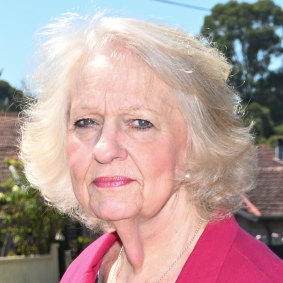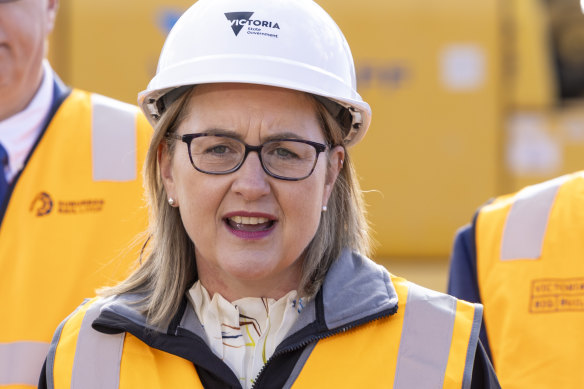This was published 7 months ago
Council slams being shut out by state over plan for $1.6b tower project
Whitehorse City Council had to lodge a freedom-of-information request just to get basic details about the Allan government’s plans for a massive seven-tower development in Melbourne’s east before it was approved without the council’s final say.
Whitehorse Mayor Denise Massoud lashed a pattern of consistently cutting out local government and said the council had only learnt that the Planning Minister, Sonya Kilkenny, had approved the $1.57 billion Vicinity Centres project – which will change the shape of Box Hill with towers up to 50 storeys and a total of 1700 apartments – when staff saw an Age report on Monday.

Box Hill’s skyline, seen from Whitehorse Road in February last year.Credit: Scott McNaughton
The state government seized planning control last year of the 18,500-square-metre masterplan through the state’s Development Facilitation Program, a scheme that was expanded last year to fast-track major projects.
The development falls within the government’s Box Hill station precinct for the first stage of the $34.5 billion Suburban Rail Loop.
While Box Hill already has Melbourne’s tallest skyline outside the CBD, Whitehorse Council has previously described Vicinity’s masterplan as “fatally flawed” and expressed concerns over building heights, open space, wind tunnelling, overshadowing and transport impacts.
Massoud said that when the council received no response to its submission and no information about how plans for the development were progressing, it tried to access details through a freedom- of-information request to the Department of Transport and Planning in November.
However, the council said the department provided only a heavily redacted version of the document sought – a report by the state government-appointed advisory committee assessing the masterplan – because it claimed it was not in the public interest and could lead to confusion, mischief and pointless, ill-informed debate.
“We wanted to know if any of our concerns had been taken on board,” Massoud said on Monday.
A state government spokeswoman said it would have been inappropriate to release the full report requested by the council under freedom of information until a decision on the development was finalised.
She said the planning department would work with the council once it received the developer’s detailed design plans covering wind impact and other factors.
On Monday, Premier Jacinta Allan questioned why the council was opposed to more residential development.
“It’s probably up to Whitehorse Council to explain to their community why they don’t want to provide the opportunity for more residents to live close to such great public transport options,” Allan said.
Massoud rejected those comments, and said the council supported building more apartments in Box Hill, including the 50-storey tower, as long as new open space, schools and health services were also delivered. The council has warned of a potential “catastrophic” lack of parkland.

Whitehorse Mayor Denise Massoud.Credit: Justin McManus
“What we’re calling on is for good, long-term planning to adequately meet future community needs,” Massoud said.
The mayor said the council’s experience with the Box Hill Central masterplan reflected what was happening more broadly with the Suburban Rail Loop planning process.
The Suburban Rail Loop Authority took planning control over a 1.6-kilometre radius around each of the six stations of the railway line that will run between Box Hill and Cheltenham. Massoud said the council had been sidelined ever since the authority started designing precincts.
“There’s no discussion about what the concerns of the community are, and respecting the community is important,” she said.
“We would really like the government to sit with us and take on the intimate knowledge we have.”
Three municipalities that will be home to Suburban Rail Loop stations have released new draft submissions to be considered at council meetings this week. While supportive of improved transport, the councils are scathing of the planning process.
Whitehorse Council’s submission demands detail on how the development around Box Hill station will be funded, the proposed form and design of the new towers, community infrastructure and whether the council’s existing strategic work was considered. The Box Hill and Burwood train stations will be within Whitehorse’s boundaries.
“Council reiterates its desire to see a robust and transparent process,” the Whitehorse submission says.
The City of Monash, which takes in Glen Waverley, Monash and Clayton stations, says its overriding concern is lack of clarity around the planning process, such as vague language about objectives for vital streets.
“The lack of even basic detail and identification of key issues and challenges is a significant shortcoming,” the Monash submission says.
“This has often made it challenging for council to properly consider and respond to the material, particularly as some material is released with little notice.”
The City of Kingston, which takes in Cheltenham, says it is reiterating the need to see the data and rationale used by the state government to arrive at its projected population and employment figures.
“Council has made several requests for the technical background reports and studies,” Kingston’s submission says.
“Without an appreciation of how the SRLA [the authority] have arrived at their proposed plans, it is difficult to provide informed feedback.”
A spokeswoman for the Suburban Rail Loop Authority said a large program of community consultation was under way.
“This year we’ve had more than 60 hours of collaborative workshops with councils … on top of regular fortnightly meetings,” she said.
RMIT University planning professor Michael Buxton said while councils were fed up with being shut out of SRL precinct planning, the system was working as designed because the state government flipped usual planning processes when it handed over powers to the authority.
“The government designed the process to exclude councils and the community,” Buxton said.
“It’s authoritarian for a start ... [and] it divests control to a statutory authority, the SRLA, that has very little planning expertise.”
The state government has also threatened to strip planning controls from Victorian councils that fail to meet new housing targets.
Municipal Association of Victoria president David Clark said it was crucial for the state to meaningfully include councils in decision-making.
“The state considers itself to be all-seeing and all-knowing, and I think it’s far from that,” Clark said.

Victorian Premier Jacinta Allan at a Suburban Rail Loop site in February.Credit: Wayne Taylor
The government has yet to detail how it plans to fund the Suburban Rail Loop, with only $11.8 billion committed by the state and $2.2 billion from the Commonwealth so far.
The business case also proposes raising billions of dollars from “value capture” charges on properties around the new train stations that increase in value thanks to the project, but the mechanism has yet to be determined.
When asked on Monday whether the Vicinity Centres Box Hill development would help fund the SRL, Allan said: “We will continue to work through value capture opportunities.”
Buxton warned of a possible conflict of interest if the state approved developments and also benefited from their value capture. “The higher the towers are approved, the more money it gets.”
Opposition Leader John Pesutto has vowed to pause and review the construction of the SRL should the Coalition win government at the next state election, due in 2026, which is also the year tunnelling is set to begin.
A Vicinity Centres spokeswoman said building heights in the company’s Box Hill masterplan were consistent with the area, and the company was working with the SRL Authority.
Get the day’s breaking news, entertainment ideas and a long read to enjoy. Sign up to receive our Evening Edition newsletter here.